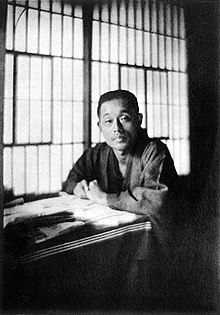Masamune Hakucho
Masamune Hakuchō ( Japanese 正宗 白鳥 , real name: Masamune Tadao ( 正宗 忠 夫 ); born March 3, 1879 in Bizen , Okayama Prefecture ; † October 28, 1962 ) was a Japanese critic, writer and playwright and a leading exponent of Japanese naturalism ( Shizenshugi ).
Life
Masamune Hakuchō was born as the eldest son of Masamune Uraji ( 浦 二 ) and Mine ( 美 禰 ). He comes from a family that had been fishermen for many generations and then also timber merchants with his great-grandfather. As a result, his parents were wealthy landowners. After graduating from Shizutani Gakkō ( 閑 谷 学校 ), he attended the Tōkyō Senmon Gakkō (today: Waseda University ) from 1896 . Under the influence of Uemura Masahisa and Uchimura Kanzo , he was baptized and became a Christian. Although he was enrolled in history and English, he graduated in literature in 1901. He then worked in the publishing department of Waseda University and then for the Yomiuri Shimbun .
In 1908 he left the Yomiuri Shimbun to devote himself full-time to writing. In 1911 he married Tsune ( つ 禰 ), the daughter of the oil trader Shimizu Tokubei ( 清水 徳 兵衛 ) from Kofu .
In 1935 he founded the Japanese PEN Center with Shimazaki Tōson and Tokuda Shūsei on behalf of the Department of Cultural Affairs of the Ministry of Foreign Affairs , of which he was chairman from 1943 to 1947. In 1962 Masamune Hakuchō died of pancreatic cancer at the age of 83.
Of his six brothers and three sisters, his younger brothers, the painter Masamune Tokusaburō ( 正宗 得 三郎 ), the Kokugakusha Masamune Atsuo ( 正宗 敦夫 ) and the botanist Masamune Genkei ( 厳 敬 ) are also known.
Prizes and awards
- 1950 Order of Culture
- 1959 Yomiuri Literature Prize for Kotoshi no aki
Works (selection)
Novels
- 1904 Sekibaku ( 寂寞 )
- 1908 Doko e ( 何処 へ )
- 1911 Doro ningyō ( 泥 人形 )
- 1916 Ushibeya no nioi ( 牛 部屋 の 臭 ひ )
- 1949–53 Nihon dasshutsu ( 日本 脱出 )
Plays
- 1923 Jinsei no kōfuku ( 人生 の 幸福 )
Reviews
- 1938 Bundanteki jijoden ( 文壇 的 自叙 伝 , roughly: a literary autobiography)
- 1948 Shizenshugi seisuishi ( 自然 主義 盛衰 史 , for example: History of the rise and fall of Japanese naturalism)
- 1941–42 Sakka-ron ( 作家 論 )
Web links
- Works by Masamune Hakuchō near Aozora (Japanese)
- Biographical summary at Kotobank (Japanese)
- Japanese Literature
Individual evidence
- ↑ Kotobank
- ↑ 正宗 家 ・ 亀 屋 - Excerpt from the family tree (Japanese)
| personal data | |
|---|---|
| SURNAME | Masamune Hakucho |
| ALTERNATIVE NAMES | 正宗 白鳥 (Japanese, pseudonym); Masamune Tadao (real name); 正宗 忠 夫 (real name, Japanese) |
| BRIEF DESCRIPTION | Japanese writer |
| DATE OF BIRTH | March 3, 1879 |
| PLACE OF BIRTH | Bizen |
| DATE OF DEATH | October 28, 1962 |

